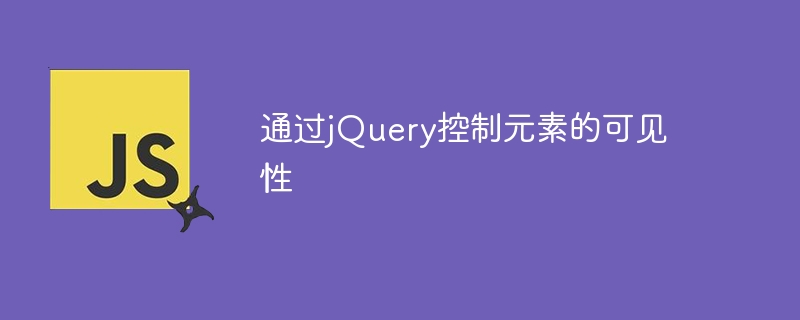

Controlling the visibility of elements through jQuery requires specific code examples
In web development, controlling the visibility of elements is a very common operation. jQuery is a widely used JavaScript library that provides rich methods to manipulate web page elements, including controlling the visibility of elements. With jQuery, we can easily hide or show elements in web pages through code to achieve interactive effects and page control. Next, I will teach you how to use jQuery to control the visibility of elements through specific code examples.
First, we need to introduce the jQuery library into the page, which can be introduced through a CDN link or downloaded locally. After introducing the jQuery library, we can use its methods to control the visibility of elements.
First, let’s take a look at how to use jQuery to hide an element. We can use the hide() method to hide an element. The sample code is as follows:
<!DOCTYPE html>
<html>
<head>
<title>隐藏元素示例</title>
<script src="https://cdn.bootcdn.net/ajax/libs/jquery/3.5.0/jquery.min.js"></script>
<script>
$(document).ready(function(){
$("#hideButton").click(function(){
$("#elementToHide").hide();
});
});
</script>
</head>
<body>
<div id="elementToHide">
这是要隐藏的元素。
</div>
<button id="hideButton">点击隐藏</button>
</body>
</html>In the above example, we hide the id as # by clicking the button ##elementToHide element. When the button is clicked, the element will be hidden through the hide() method.
show() method to display an element. The sample code is as follows:
<!DOCTYPE html>
<html>
<head>
<title>显示元素示例</title>
<script src="https://cdn.bootcdn.net/ajax/libs/jquery/3.5.0/jquery.min.js"></script>
<script>
$(document).ready(function(){
$("#showButton").click(function(){
$("#elementToShow").show();
});
});
</script>
</head>
<body>
<div id="elementToShow" style="display:none;">
这是要显示的元素。
</div>
<button id="showButton">点击显示</button>
</body>
</html>id to The element of elementToShow is set to display:none;, which means it will not be displayed when the page is loaded. When the button is clicked, the element will be displayed through the show() method.
toggle() method to toggle the visibility of elements. The sample code is as follows:
<!DOCTYPE html>
<html>
<head>
<title>切换元素可见性示例</title>
<script src="https://cdn.bootcdn.net/ajax/libs/jquery/3.5.0/jquery.min.js"></script>
<script>
$(document).ready(function(){
$("#toggleButton").click(function(){
$("#elementToToggle").toggle();
});
});
</script>
</head>
<body>
<div id="elementToToggle">
这是要切换可见性的元素。
</div>
<button id="toggleButton">点击切换可见性</button>
</body>
</html>id being elementToToggle will pass toggle() Method to switch the hidden and displayed states to achieve switching of element visibility.
The above is the detailed content of Use jQuery to manage the display and hiding of elements. For more information, please follow other related articles on the PHP Chinese website!
